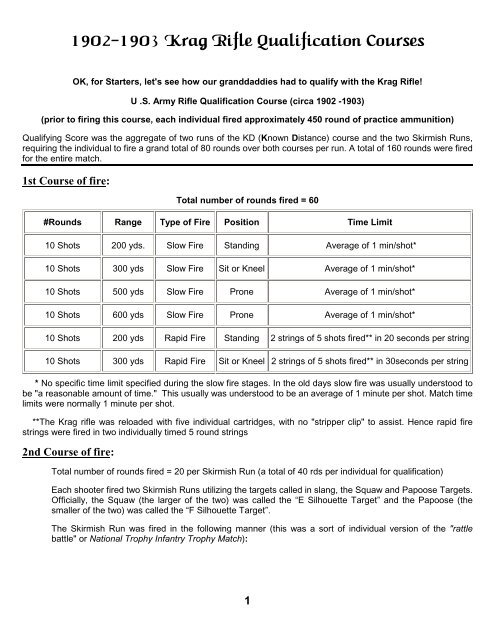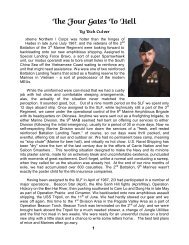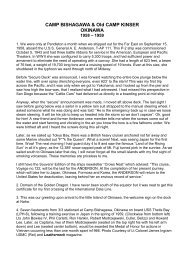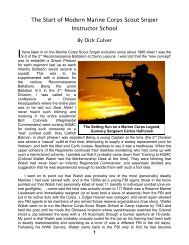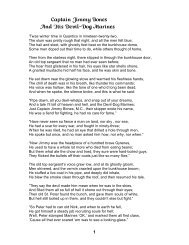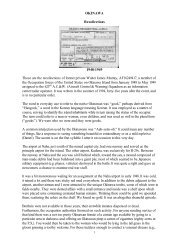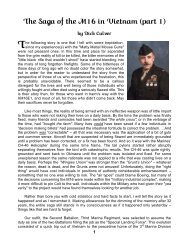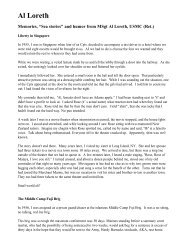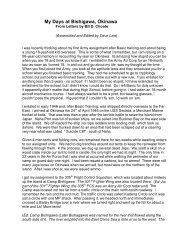Krag Rifle Qualification Course 1902-1903 - Rohrer, Bob Rohrer
Krag Rifle Qualification Course 1902-1903 - Rohrer, Bob Rohrer
Krag Rifle Qualification Course 1902-1903 - Rohrer, Bob Rohrer
Create successful ePaper yourself
Turn your PDF publications into a flip-book with our unique Google optimized e-Paper software.
<strong>1902</strong>-<strong>1903</strong> <strong>Krag</strong> <strong>Rifle</strong> <strong>Qualification</strong> <strong>Course</strong>s<br />
OK, for Starters, let's see how our granddaddies had to qualify with the <strong>Krag</strong> <strong>Rifle</strong>!<br />
U .S. Army <strong>Rifle</strong> <strong>Qualification</strong> <strong>Course</strong> (circa <strong>1902</strong> -<strong>1903</strong>)<br />
(prior to firing this course, each individual fired approximately 450 round of practice ammunition)<br />
Qualifying Score was the aggregate of two runs of the KD (Known Distance) course and the two Skirmish Runs,<br />
requiring the individual to fire a grand total of 80 rounds over both courses per run. A total of 160 rounds were fired<br />
for the entire match.<br />
1st <strong>Course</strong> of fire:<br />
Total number of rounds fired = 60<br />
#Rounds Range Type of Fire Position Time Limit<br />
10 Shots 200 yds. Slow Fire Standing Average of 1 min/shot*<br />
10 Shots 300 yds Slow Fire Sit or Kneel Average of 1 min/shot*<br />
10 Shots 500 yds Slow Fire Prone Average of 1 min/shot*<br />
10 Shots 600 yds Slow Fire Prone Average of 1 min/shot*<br />
10 Shots 200 yds Rapid Fire Standing 2 strings of 5 shots fired** in 20 seconds per string<br />
10 Shots 300 yds Rapid Fire Sit or Kneel 2 strings of 5 shots fired** in 30seconds per string<br />
* No specific time limit specified during the slow fire stages. In the old days slow fire was usually understood to<br />
be "a reasonable amount of time." This usually was understood to be an average of 1 minute per shot. Match time<br />
limits were normally 1 minute per shot.<br />
**The <strong>Krag</strong> rifle was reloaded with five individual cartridges, with no "stripper clip" to assist. Hence rapid fire<br />
strings were fired in two individually timed 5 round strings<br />
2nd <strong>Course</strong> of fire:<br />
Total number of rounds fired = 20 per Skirmish Run (a total of 40 rds per individual for qualification)<br />
Each shooter fired two Skirmish Runs utilizing the targets called in slang, the Squaw and Papoose Targets.<br />
Officially, the Squaw (the larger of the two) was called the “E Silhouette Target” and the Papoose (the<br />
smaller of the two) was called the “F Silhouette Target”.<br />
The Skirmish Run was fired in the following manner (this was a sort of individual version of the "rattle<br />
battle" or National Trophy Infantry Trophy Match):<br />
1
1. Each shooter had one (each) Squaw and Papoose Target sitting on top of the butts in front of his firing<br />
point - any firing position was allowed at all ranges (you could shoot prone at all distances if you wished):<br />
2. The line of shooters formed just to the rear of the 600 yd line in a skirmish line. When the line was formed,<br />
it was ordered forward ("well dressed" needless to say) to the 600 yd. firing point and halted. On<br />
command, each shooter fired 2 rounds at the target(s) within a time limit of 30 seconds.<br />
3. Upon expiration of the 30 sec. time limit the line was ordered forward to the 500 yd. line. The first half of<br />
the distance was covered in quick time and the last half at double time. At 500 yds. 2 rounds were fired at<br />
the target in a time limit of 30 seconds.<br />
4. Upon expiration of the 30 sec. time limit, the line was ordered forward to the 400 yd. line. Again, the<br />
distance was covered first in a quick time with the last half done at the double. At 400 yds. 3 rounds were<br />
fired in 30 seconds (vice 2 at 500 & 600).<br />
5. Upon expiration of the 30 sec. time limit, the line was ordered forward to the 350 yd. line, using the<br />
combination quick and double time routine (which would be continued through the end of all courses fire<br />
during the skirmish runs). Again you were required to shoot 3 shots in 30 seconds, just as at 400 yds.<br />
6. Upon expiration of the 30 sec time limit, the line was ordered to the 300 yd line. Here you had a total of 10<br />
rds. remaining. The individual shooter was allowed to distribute these in any way he wished between the<br />
300 and 200 yd line. He had another 30 second time limit at 300 yds, but this was cut to 20 sec. at 200<br />
yds.<br />
Old timers were said to have favored the prone position at all ranges with a few diehards using the sitting<br />
position at 200. Total possible score was 100. An extremely accomplished shooter of the day was thought to<br />
be doing well if he scored 80 or more points on a skirmish run.<br />
Put into table form, it would look like this:<br />
Skirmisher’s <strong>Course</strong><br />
Range # of Rounds Fired Time Limit Position<br />
600 yds 2 30 sec Any<br />
500 yds. 2 30 sec. Any<br />
400 yds. 3 30 sec Any<br />
350 yds. 3 30 sec Any<br />
300 yds<br />
10 rds. to be used at shooter’s<br />
30 sec. Any<br />
200 yds.<br />
discretion<br />
20 sec. Any<br />
Two Targets per Shooter: Squaw = 4 points Papoose = 5 points<br />
Movement between yard lines = 1/2 quick time - 1/2double time<br />
Shooters move as a skirmish line "downrange" on command.<br />
2
As a strategy, most competitors fired at the Squaw (kneeling) target down to and including 350 yds. They<br />
then fired at the Papoose (prone) target at 300 and 200 yards. Col. Towsend Whelen said that he<br />
personally used the junction of the target and the ground as an aiming point, and set his sights to hit into<br />
the (wider) shoulder area of the kneeling target<br />
Sgt. Emmit Hawkins of the 24th Infantry (colored), is thought to be the 1st and only man to ever make a<br />
perfect (100 points) score in the Skirmish Run in competition.<br />
The qualifications in those far off days were:<br />
Highest = Sharpshooter<br />
2nd = Marksman<br />
3rd = 1st Class<br />
(I haven’t been able to come up with the score for each classification yet, but I’m looking)<br />
Kneeling and Prone Silhouette (Skirmisher’s) Targets<br />
Skirmish targets, the "Squaw" (left)<br />
and "Papoose" (right), used at Sea Girt<br />
and elsewhere in military shooting.<br />
These targets were also used as a part<br />
of the National Trophy Individual <strong>Rifle</strong><br />
Match in the early days, when the "leg"<br />
course required the individual to add<br />
his Skirmish Run to his National Match<br />
Score Total.<br />
Hits on Squaw Target = 4 points<br />
Hits on Papoose Target = 5 points<br />
Would you say that this is a far cry from the 40 rounds fired from the "mousegun" at the 1000 inch<br />
range that now passes for Army rifle qualification? You are now introduced to rifle marksmanship,<br />
march to the 1000 inch range, fire your rounds and head for chow all in one morning. "Poof"!! that's<br />
it! Instant "rifleman" - I'll bet you think I kidding? I would that I was! Sorry folks, that's it! End of<br />
story! A man had to be a real rifleman in those far off days of the <strong>Krag</strong> <strong>Rifle</strong> - and it would be<br />
almost 72 years until we lost our first war! It might be difficult to establish a genuine "cause and<br />
effect" between the current quality of our training, and our ability to impose our will on the enemy,<br />
but still... Of course we now understand one another so much better and of course our sensitivity<br />
training is much improved, so I suppose that has to count for something, eh what? Are we to trade<br />
political correctness for freedom? Ah well...<br />
3


